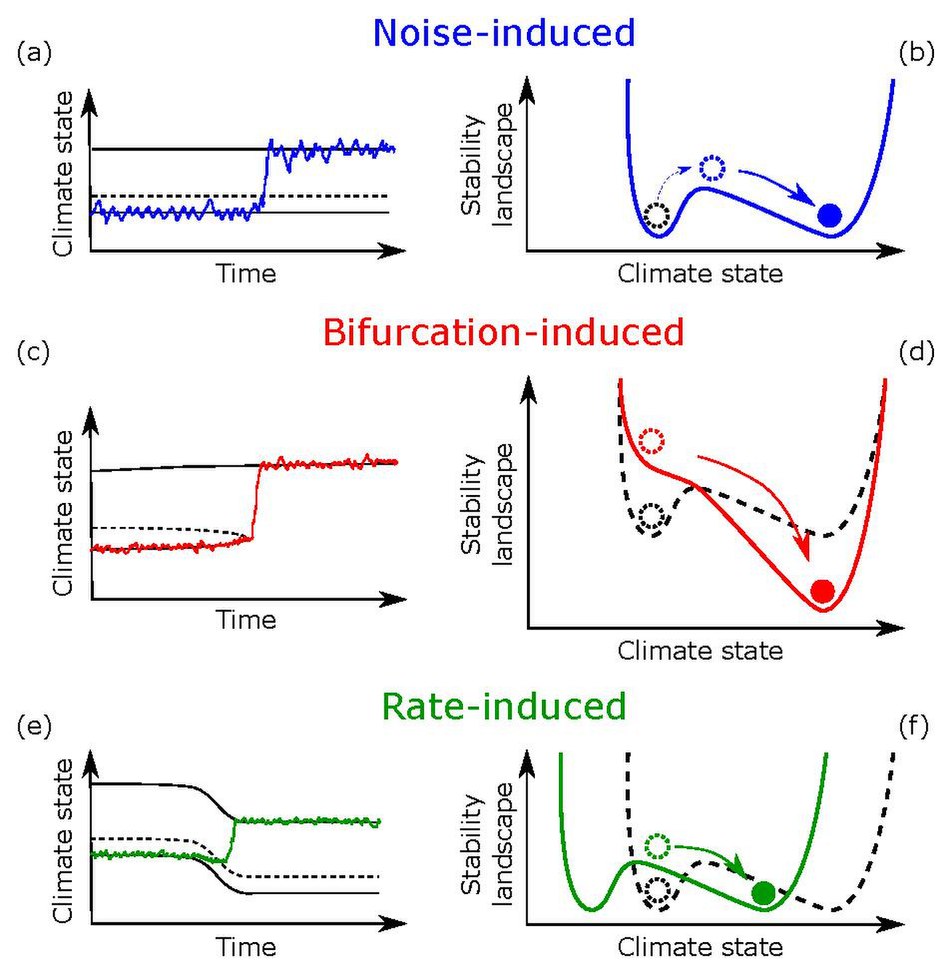Soubor:IPCC schematic wikipedia-cs.pdf
Obsah stránky není podporován v jiných jazycích.
Z Wikipedie, otevřené encyklopedie

Velikost tohoto JPG náhledu tohoto PDF souboru: 585 × 599 pixelů. Jiná rozlišení: 234 × 240 pixelů | 469 × 480 pixelů | 952 × 975 pixelů.
Původní soubor (952 × 975 pixelů, velikost souboru: 135 KB, MIME typ: application/pdf)
| Tento soubor pochází z Wikimedia Commons. Níže jsou zobrazeny informace, které obsahuje jeho tamější stránka s popisem souboru. |
Popis
| PopisIPCC schematic wikipedia-cs.pdf |
English: Illustration of three types of tipping point; (a), (b) noise-, (c), (d) bifurcation- and (e), (f) rate-induced. (a), (c), (e) example time-series (coloured lines) through the tipping point with black solid lines indicating stable climate states (e.g. low or high rainfall) and dashed lines represent the boundary between stable states. (b), (d), (f) stability landscapes provide an intuitive understanding for the different types of tipping point. The valleys represent different climate states the system can occupy with hill tops separating the stable states. The stability of a climate state is implied by both the depth of the valley and the distance to the hill top. The current state of the system is represented by a ball. All scenarios assume that the ball starts in the left hand valley (black dashed lines) and then through different mechanisms dependent on the type of tipping transitions to the right valley (coloured lines). Noise-induced tipping events, for instance Dansgaard-Oeschger events, materialise from natural fluctuations within the system. The stability landscape in this scenario remains fixed and stationary. A series of perturbations in the same direction or one large perturbation are required to force the system over the hill top and into the alternative stable state. Bifurcation-induced tipping events, such as a collapse of the AMOC under climate change, occur when a critical level in the forcing is reached. Here the stability landscape is subjected to a change in shape. Under gradual anthropogenic forcing the left valley begins to shallow and eventually vanishes at the tipping point, forcing the system to transition to the right hand valley. Rate-induced tipping events, for example combustion of compost heaps (compost bomb instability), arise when a system is unable to adapt (sufficiently quickly) to its changing environment. The stability landscape remains fixed in shape but instead gets dragged/pushed. Consider the stability landscape being dragged to the left. The ball will lag behind the moving valley. There exists a critical rate at which the landscape is dragged such that for slower rates the ball will remain in the left valley. However, rates faster than the critical rate and the ball will lag too far behind such that it moves over the hill top and consequently transition to the right hand valley. |
| Datum | |
| Zdroj | Vlastní dílo |
| Autor | Paul Ritchie, translation Jirka Dl |
| Další verze |
 |
Licence
Já, držitel autorských práv k tomuto dílu, ho tímto zveřejňuji za podmínek následující licence:
Tento soubor podléhá licenci Creative Commons Uveďte autora-Zachovejte licenci 4.0 International
- Dílo smíte:
- šířit – kopírovat, distribuovat a sdělovat veřejnosti
- upravovat – pozměňovat, doplňovat, využívat celé nebo částečně v jiných dílech
- Za těchto podmínek:
- uveďte autora – Máte povinnost uvést autorství, poskytnout odkaz na licenci a uvést, pokud jste provedli změny. Toho můžete docílit jakýmkoli rozumným způsobem, avšak ne způsobem naznačujícím, že by poskytovatel licence schvaloval nebo podporoval vás nebo vaše užití díla.
- zachovejte licenci – Pokud tento materiál jakkoliv upravíte, přepracujete nebo použijete ve svém díle, musíte své příspěvky šířit pod stejnou nebo slučitelnou licencí jako originál.
Popisky
Schéma znázorňující rozdíly v typech bodů zlomu.
Schematic illustrating differences in types of tipping.
Položky vyobrazené v tomto souboru
zobrazuje
3. 1. 2020
Historie souboru
Kliknutím na datum a čas se zobrazí tehdejší verze souboru.
| Datum a čas | Náhled | Rozměry | Uživatel | Komentář | |
|---|---|---|---|---|---|
| současná | 13. 9. 2023, 09:50 |  | 952 × 975 (135 KB) | Jirka Dl | better translation |
| 11. 9. 2023, 14:28 |  | 952 × 975 (91 KB) | Jirka Dl | Uploaded own work with UploadWizard |
Využití souboru
Tento soubor používá následující stránka:
Metadata
Tento soubor obsahuje dodatečné informace, poskytnuté zřejmě digitálním fotoaparátem nebo scannerem, kterým byl pořízen. Pokud byl soubor od té doby změněn, některé údaje mohou být neplatné.
| Datum a čas digitalizace | 28. 7. 2022, 10:45 |
|---|---|
| Datum a čas vytvoření obrázku | 13. 9. 2023, 11:46 |
| Datum poslední úpravy metadat | 13. 9. 2023, 11:46 |
| Konverzní program | cairo 1.16.0 (https://cairographics.org) |
| Šifrovaný | no |
| Velikost stránky | 457.773 x 468.65 pts |
| Verze formátu PDF | 1.5 |
